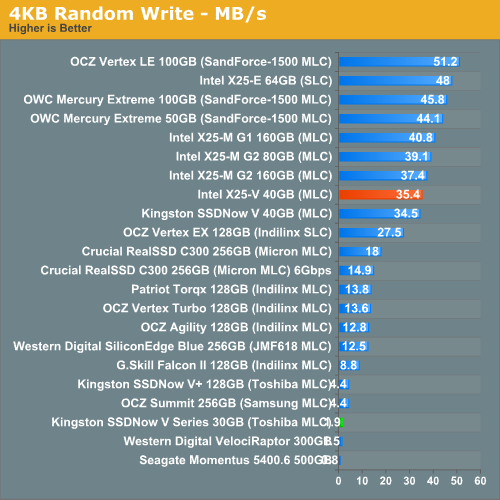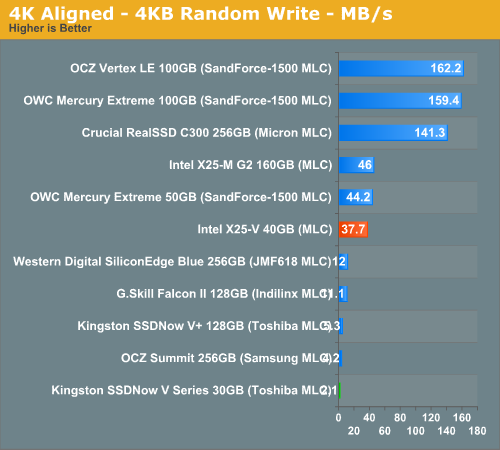Intel's X25-V & Kingston's 30GB SSDNow V Series: Battle of the $125 SSDs
by Anand Lal Shimpi on March 19, 2010 12:00 AM EST- Posted in
- Storage
Random Read/Write Speed
This test reads/writes 4KB in a completely random pattern over an 8GB space of the drive to simulate the sort of random access that you'd see on an OS drive (even this is more stressful than a normal desktop user would see). I perform three concurrent IOs and run the test for 3 minutes. The results reported are in average MB/s over the entire time.
I've had to run this test two different ways thanks to the way the newer controllers handle write alignment. Without a manually aligned partition, Windows XP executes writes on sector aligned boundaries while most modern OSes write with 4K alignment. Some controllers take this into account when mapping LBAs to page addresses, which generates additional overhead but makes for relatively similar performance regardless of OS/partition alignment. Other controllers skip the management overhead and just perform worse under Windows XP without partition alignment as file system writes are not automatically aligned with the SSD's internal pages.
First up is my traditional 4KB random write test, each write here is aligned to 512-byte sectors, similar to how Windows XP might write data to a drive:

Intel's drives have traditionally done very well in random write tests and the X25-V is no different. Here it performs like a much more expensive X25-M G2. The SSDNow V Series Boot Drive however is at the bottom of the charts in single digits here.
Running 4K aligned writes (similar to Windows 7 or OS X 10.5/6) doesn't improve the situation much in either case:

Random read performance is equally strong for Intel:

And equally weak for Kingston.










78 Comments
View All Comments
Anand Lal Shimpi - Friday, March 19, 2010 - link
The SSD Toolbox won't work on RAID volumes unfortunately.Take care,
Anand
buzznut - Monday, March 22, 2010 - link
Thanks Anand for clarifying the raid and SSD toolbox issues. I can see now that adding a second 40 GB drive will not be a good idea and I should save for a larger capacity.I am very interested in knowing when Intel gets trim working for raid! Good to know I can count on Anandtech for the latest SSD news. Thanks again, Scott
pkoi - Friday, March 19, 2010 - link
The difference between 30gb and 40gb is HUGE,,, I would need 50 to swap my bloated win7inighthawki - Friday, March 19, 2010 - link
I have a 30GB partition for Win7 and still have 8GB left, and that's after some pretty careless space management. I don't understand how yours can be so bloated. You're not counting things like program files, are you? You're aware that the users and program files folders aren't part of your windows installation, right?gerstena - Friday, March 19, 2010 - link
"I have a 30GB partition for Win7 and still have 8GB left, and that's after some pretty careless space management."Unfortunately things like volume shadow services and the source files of windows updates quickly eat up the space. A lot of users won't know about these things.
The only thing I have found drives under 60 GB useful for are speeding up database operations and development.
hoohoo - Tuesday, March 23, 2010 - link
I have 8 GB for OpenSuSE 11.2 and still have 3 GB free.I dunno about Windows bloat - yours or the other guy's!
davepermen - Friday, March 19, 2010 - link
I need one. it would be enough for 3 windows 7.no clue how bloated yours is :)
loimlo - Tuesday, March 30, 2010 - link
Dear AnandYour nice review of Kingston indeed encouraged me to purchase Kingston 64GB SSD for my win7 system, but your TRIM comment just kept my purchase impulse at bay. Would you mind clarifying the TRIM situation in the future? If nothing wrong with TRIM implementation on Kingston SSD, I'll buy bigger brother, 64GB SSD, for my system immediately!
Thanks